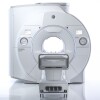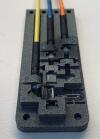How AI and remote monitoring are revolutionizing MR maintenance
by John R. Fischer, Senior Reporter | December 18, 2023
MRI
With the amount of machine data that AI can collect, manufacturers are also using the technology to create digital twins of MR scanners to help predict failures before they happen on applicable real-world systems. Using complex algorithms, these solutions can visualize and display vast quantities of data and run simulations to show how a machine will likely behave under specific conditions.
As AI becomes more refined and learns to identify new patterns and changes, the deployment of digital twins for MR servicing will grow and evolve, providing OEMs with additional capabilities for monitoring and addressing diverse issues under a range of circumstances.
New Fully Configured 80-slice CT in 2 weeks with Software Upgrades for Life
For those who need to move fast and expand clinical capabilities -- and would love new equipment -- the uCT 550 Advance offers a new fully configured 80-slice CT in up to 2 weeks with routine maintenance and parts and Software Upgrades for Life™ included.

“This is where we use data and the information that's collected on a daily basis,” said Hani Chohan, VP for service growth for GE HealthCare U.S. and Canada. “A virtual model helps us predict things like the estimated remaining life of the component that's being monitored, and that helps us then look at the alerts around the environment coil, MR magnets, cryo, and more.”
GE HealthCare is leveraging this advanced technology with its OnWatch Predict solution, which combines remote monitoring and predictive analytics and creates models and alerts for changes in the MR imaging environment, image quality, magnets and cryos, patient handling, and core system, among other variables.
As a result of these and other potential capabilities fostered by AI, service plans for MR scanners are expected to incorporate a more usage- or condition-based preventive maintenance approach in their designs, further simplifying and accelerating maintenance and repairs for both OEM service manufacturers and the healthcare providers they serve.
“We will monitor more functions and come in when it is necessary instead of following a rigid preventive maintenance pattern. Always, the idea should be to create as few interruptions as possible, but as much as you need to keep the scanner up and running,” said Mark Lothert, head of product management for services for the U.S. at Siemens Healthineers.
Knowing servicing needs in advance
According to Chohan, utilizing AI and remote monitoring effectively requires providers to know and communicate everything they can about their MR imaging operations to the OEM. “They have to understand what they want from their service and support. What are some of those metrics or provisions that the service contract needs to have in place? For example, is it to minimize unplanned downtime, or the details around coverage response time? What's excluded, what's included with after-hour support, uptime guarantee, things like that.”
You Must Be Logged In To Post A CommentRegisterRegistration is Free and Easy. Enjoy the benefits of The World's Leading New & Used Medical Equipment Marketplace. Register Now! |
|















